Nov - Dec Offensive |
Table of Contents |
Battle of the Bulge |
Nov - Dec Offensive |
Table of Contents |
Battle of the Bulge |
Completely ready in every sense of the word the battalion moved out of Tomblaine at 0800 on November 8th to an assembly area south of Leyr. It was raining heavily when we closed in bivouac there at 1000, and we spent the night there.
The following day, with the rain still pouring down and the ground becoming increasingly muddy and boggy, TF Davall travelled to a forward assembly area in the vicinity of Menoncourt. But, even such miserable conditions did not dampen the men's certainty that we were starting on the final drive to end the war by Christmas. In addition to the downpour's muddying up the ground, the Seille River had reached flood level, and during the night the approaches to the pontoon bridge north of Menoncourt were washed out. So, unable to cross the river, we remained in our assembly area that night.
On the morning of the tenth, we moved up to Nomeny and crossed the river there, and as continuous maintenance of the approaches was necessary the pontoon bridge proved to be a traffic bottleneck, and our tail didn't clear until early in the afternoon. Then, we proceeded north through Mailly-Sur-Seille to the Bois De Seigneur. We contacted no enemy on this approach, but our progress was greatly hampered by fallen trees on the road, and we couldn't risk taking to the open fields because of the terrain's boggy condition. With the task force in an approach march formation, "A" Company was in the advance guard, and it used the dozer tank to clear the trees from the route. The advance guard moved from Secourt by way of Sailly to Achatel, and as the bridge across the railroad north of Achatel was destroyed, "A" Company left the road and forced a crossing in order to support an attack by the 318th Infantry Regiment on the town of Moncheux. The remainder of the task force turned back to Secourt, and proceeded northeast to a grade crossing of the same railroad, and thence southeast to Moncheux. When they arrived there, they found the town already captured by the doughs. So, Task Force Davall went into bivouac northeast of the Moncheux. During the night, we were subjected to severe shelling.
Next morning, the task force jumped off and continued its drive east. The advance guard encountered a culvert on the road to Tragny, and the bridge across the stream southwest of the town was completely demolished by the enemy early that morning. An attempt to cross was impossible, so the force turned back and tried to proceed on secondary roads through the BOIS DE JUVILLE, but all trails through these woods were discovered impassable. Our leading element became bogged down while trying to bypass the woods to the south; this also resulted in their being subjected to heavy artillery and mortar fire. Then, a new combat team was formed from elements of the task force, which included Companies "A" and "D" under the command of Major Britton, Battalion Exec. Their mission was to move cross country and to be in direct support of Task Force Elm, made up mainly of the 318th Infantry Regiment, in their attack on Tragny and Thimonville. Meanwhile, the rest of Task Force Davall returned to the main road to Tragny to await the completion of the engineer bridge. During this time Combat team Britton was busy cleaning out Thimonville of enemy troops who had remained hidden or filtered back into the town after the infantry regiment had passed through. After finishing this task, Major Britton moved his unit toward Morville sur Nied and thence toward Baudrecourt. The ground was still not suited to tank warfare and General "Mud" still held full command of the area. The bridge south of Baudrecourt was found destroyed and the combat team was ordered to bivouac southwest of the town. The remainder of Col. Davall's moved east when the three bridges in the vicinity of Tragny were completed, then later closed in bivouac at Morville sur Nied after dark, and remained there for the night. During the night, an attached engineer platoon was sent forward to repair the blown bridge holding up Combat Team Britton south of Baudrecourt. The unit under Maj . Britton was once again under the direct control of the Battalion commander.
That night
the engineers, while working under very difficult conditions, completed
the bridge at Baudrecourt, and on the morning of the twelfth our elements
crossed and entered the town. Our leading elements ran into light resistance
and small arms fire but continued forward. Company A was sent to join 9th
Armd, Infantry Battalion and moved north from town with the mission of
seizing and holding the bridge across the La Rotte River, between Baudrecourt
and Vatimont. The bridge was found to be demolished. While in that area
the unit was ambushed just north of the railroad tracks which ran by the
river. Company A having two platoons back as a holding and covering force
was able to extricate the one platoon receiving the fire. Meanwhile Company
C was dispatched northeast of the town to block all approaches in that
area. Company D moved out of town on a road south and east of town, blocking
that approach. Reports from prisoners, and aerial reconnaissance were that
the enemy was well dug in in all areas east of Baudrecourt. They had good
artillery and direct fire support, plus terrain features which were to
their credit. At 1400, some units of the 318th Infantry Regiment who moved
into to town prepared to attack across the river and establish a bridgehead
on the north side so that the engineers could repair the bridge. Company
A took up positions generally along the railroad track south of the river
and prepared to support this attack by direct fire. The new attack began
shortly after 1400 and coincided with an attack by Task Force Godfrey on
Vatimont at our left. Little opposition was encountered and the bridgehead
was successfully established. Meanwhile Companies A, C, and D were drawn
into defensive positions around the north and east side of town, and a
security detachment was provided for the engineers during the construction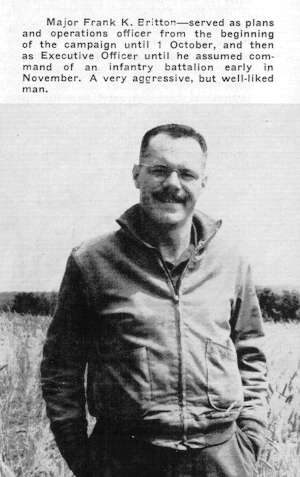 of
their bridge. The enemy had used a great deal of artillery while in their
defensive positions and as we neared their batteries these guns were fired
as direct fire weapons. We paid a high price in officers during this small
offensive: Lt. Thomas G. Hill, company commander of Company C was killed
by artillery fire while dismounting from his tank. Also, Capt. Klotz, commanding
Company A was wounded and evacuated as well as some much needed platoon
leaders. In many Companies Platoon Sgts. were now placed in charge of platoons.
The loss of two company commanders as well as some platoon leaders meant
a complete reorganization of the leaders of the Battalion. The Task Force,
meanwhile, remained in Baudrecourt during the night. Heavy shelling continued
at night, which meant that "Jerry" was not moving out and was going to
hold his ground.
of
their bridge. The enemy had used a great deal of artillery while in their
defensive positions and as we neared their batteries these guns were fired
as direct fire weapons. We paid a high price in officers during this small
offensive: Lt. Thomas G. Hill, company commander of Company C was killed
by artillery fire while dismounting from his tank. Also, Capt. Klotz, commanding
Company A was wounded and evacuated as well as some much needed platoon
leaders. In many Companies Platoon Sgts. were now placed in charge of platoons.
The loss of two company commanders as well as some platoon leaders meant
a complete reorganization of the leaders of the Battalion. The Task Force,
meanwhile, remained in Baudrecourt during the night. Heavy shelling continued
at night, which meant that "Jerry" was not moving out and was going to
hold his ground.
By this time, it was evident to all that a piledriving breakthrough, as was the case in Normandy and Brittany, would not be on the menu here; more in the order of a steady hammering, grinding drive for time in order to withdraw the necessary troops to the Siegfried defenses, Also, quagmire fields restricted our mobility and maneuverability, and Jerry was defending ground and towns that he knew and chose. But the attack continued.
Shortly after noon on the thirteenth, we left Baudrecourt and struck out for Vatimont, but soft mud at the crossing site and the necessity for continuous road repair resulted in extremely slow operation. So it was late afternoon before the column had cleared the north bank of the river. Thence, we proceeded to Arraincourt and secured the town for the night.
Here is an interesting sidelight on our capture of Arraincourt: When "B" Company entered the town a hysterically glad character rushed out to meet the lead tank. It was an American pilot, Walter Jensen by name, who had been shot down in that vicinity several weeks before, and who had been hidden and fed since that time by a French family; he stayed with us that night, and we evacuated him the next morning, with his gratitude knowing no bounds. We on the other hand told him how sincerely we appreciated the support his fellow fighter pilots bad been giving us, and how much better we felt when we saw the destruction-bearing P-47s in the sky, and how eagerly we were waiting for them now; the rain and overcast skies bad grounded them for a long time now.
On the following morning, Task Force Davall jumped off in an attack along the axis of an east-west road through Boulange, Suisse, and Landroff. (The attack was systematically undertaken, and each of the towns was taken in the following manner). Before going into a description of the assault, there is an important factor to be considered. It was becoming more and more apparent that Jerry was sticking close to the towns in his defense, and ignoring dominating terrain features from which he could much better halt our advance. So, after careful scrutinizing and estimate of the terrain and condition of the ground, Colonel Davall employed the following plan with success: Company "C" moved east along, the high ground north of, and generally paralleling the road. Company "A," reinforced by one platoon of tank destroyers and a platoon of infantry, moved east on the road, As each town was reached, is was taken under fire by Company "A," while "C" Company began a limited enveloping movement from the high ground. When "C" Company had reached a position dominating the town, it covered by fire, while "A" Company moved in and seized the town. Forward elements were ordered to hold up at Landroff, and Captain Smith, battalion S-3 was sent forward to organize and hold the town. Company "D" was committed to secure "C" Company's left, west flank on the high ground northwest of Landroff, and extend along the high ground to the west, thus blocking the approach from the north, and protecting the Suisse-Landroff road, the only line of communications between the two towns. Our neck was sticking out, and we had to thoroughly tie-in and organize our positions. With the battalion CP in Suisse, the force in Landroff was reinforced by a second platoon of infantry, now placing in the town one medium tank company, two platoon of infantry, and one tank destroyer platoon.
At about 1800, the enemy launched a counter-attack on Landroff. He was in considerable infantry strength, and was supported by eight SP guns or tanks. Two were knocked out by "A" Company's sharp shooters, and the rest withdrew. The dismounted elements, however, continued to press the attack, but were finally driven off by all the fire we could muster, including artillery, This attack had been launched from the north and approached town along the main north-south road; it was preceded by a marked increase of artillery concentration which had been falling constantly on Landroff since the entry of the task force, and it continued to fall throughout the night, in spite of our counter-battery fire, Then, at 2100, Jerry tried another counter-attack, again from the same direction, and again he suffered heavy losses and was repulsed at 2140. The situation was becoming grim, and so the garrison there was reinforced by Company "C" of the 44th Armored Infantry Battalion. But the krauts hadn't given up by a long shot, and they attacked again at 2330. Once again, however, our hardbitten defenders drove them off with more losses. At this time, several TOTs were fired on the woods northeast of Landroff, where we determined that the Germans were forming their attacks. A total of 18 battalions, all types, fired this artillery mission.
So far
so good, but it soon developed that what had taken place up to now was
only the entree, for at 0130, Jerry made his main effort. Also, this time
again, he launched his strong infantry attack along the same axis of approach.
Our defenders stood fast, and although the main force of this attack formation
was broken before it reached the town, they threw aside their attack formation,
and desperately carried on with infiltration tactics. The night was pitch
dark, and so, under this natural concealment, they succeeded in getting
many men into town, and in cutting the eastwest road at the west end of
Landroff. Here began a melee at close quarters and hand-to-hand that went
on for the rest of the night. There were countless individual acts of heroism,
and it would be impossible to recount all of them, To name only a few,
there was Captain Smith, who performed a herculean
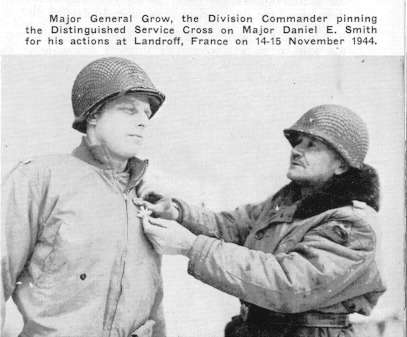
task in the defense of the town, and emerged from countless hand-to-hand combats unscratched only to be finally shot in the course of the night by a kraut dough at point blank range, but he killed him in spite of the slug he was carrying in his leg, and carried on without even stopping. He was awarded a Distinguished Service Cross for his part in the heroic defense. We can single out only a few of "A" Company's brave defenders such as S/Sgt. Shumway, Sgt. Foutch, S/Sgt. Berger, Lt. Kratzer, and T/5 Joe Kaminski, but in order to really do justice we should submit the entire "A" Company roster for heroic gallantry in repelling the foe. There was T/5 James Pye of the Medics, to mention only one of our detachment there who labored without concern for their personal safety. Suffice it to say that all there covered themselves with glory in their magnificent stand, and in so doing wrecked completely what amounted to almost an enemy division in total strength. That hectic, never-to-be-forgotten night at Landroff broke our opponent's back, and although he would still be able to delay us by bringing other troops in before us, he was never again in our sector to offer a serious threat!
We held our defensive positions there until we were passed through by elements of the 80th Division. They had finally seen the light somewhere way upstairs, and had decided that this was no spearheading breakthrough, but an infantry show. Nevertheless, when passed through by the doughs, we consolidated our positions around Landroff and Suisse, and remained there until the twenty-second of November, reorganizing, and giving our vehicles some badly needed maintenance. However, while this shake-down and rehabilitation was taking place, Company "B" was assigned to Task Force Brown, and took part in the attack of Bincheville, before reverting to 69th control. Task forces of the division alternately kept pushing Jerry back toward the Saar, and this grinding was coordinated with attacks by the doughs; the 80th had slid north to screen the corps flank and the 35th, another veteran infantry division, was now working with us. The 68th, skillfully brought along in this rehabilitation by a commander who was tops, was rounding into shape again.
On November
23rd, a platoon of engineers, a platoon of infantry, Company "D," and the
dozer were placed under CCA's direct control for a reconnaissance in force
mission in the vicinity of Lelling, and while they were on this job, Company
"D" was attached to Task Force Brown (44th AIB), and Task Force Davall
moved out for the Freybouse-Fremestroff area, Then, when its action was
no longer required at Lelling, 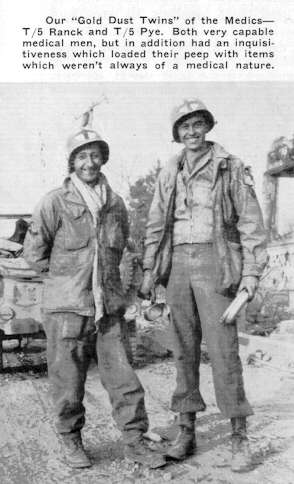 "D"
Company, now under 1st Lt. William H. Collins, returned to the fold.
"D"
Company, now under 1st Lt. William H. Collins, returned to the fold.
We almost forgot something! Here it was "Thanksgiving," and even though the setting wasn't exactly a holiday one, our commanders were determined, front line or not, to see that everyone enjoyed a thanksgiving dinner. The kitchens were brought up, and the cooks prepared excellent turkey dinners with all the fixings. At one company in particular the holiday feast will never be forgotten. "C" Company, with Task Force Brown, was undergoing very heavy shelling at Gessling-Hemering, and all the tanks were on the line. As the mess was set up in town, it was necessary for the men to infiltrate to their chow by a series of zig-zag dashes from the line. Dinner music was furnished by the screaming meemies. And while the festivities were in full swing, some heinie artilleryman, showing no respect for American customs, decided to liven up the party. He sent a well placed eighty-eight shell into a nearby manure pile, thus giving both men and food an unwelcome shower. That was how "C" Company celebrated Thanksgiving!
At 1000 on the 25th, Company "B," 68th, and Company "C" of the 44th AIB jumped off in an attack on the high grounds and woods north of Fremestroff. But the condition of the ground was still too soft, and the attack bogged down. However, the force took up defensive positions on the southern slopes of the hill north of town. Then on the following day, Companies "A" and "C" 44th launched another attack on the same hill, and had secured the objective at 1300, while undergoing heavy mortar fire. Our Companies "A" and "B" moved up to the crest and consolidated the position at 1430. The attack was preceded by heavy artillery concentrations on the woods, and on the ridge. No resistance was encountered on the ground, Incidently, this was part of the rear zone of the Maginot Line, and concrete pillboxes were built around the ground, supplemented by earthwork entrenchments. Had Jerry chosen to hold these fortified positions, he could have made it very difficult for us, but he abandoned them without a struggle; his position was untenable as Task Force Brown was in a position to outflank him from the northwest,
For the next two days we maintained defensive positions on this high ground north of Fremestroff, and awaited further orders.
On the 29th of November, we were ordered to attack and seize the towns of Lanning and Lixing. The plan called for the platoon of the 86th Recon to move out first, and slide off to the left flank, followed by "B" Company directly attacking Lixing and "C" Company of the 44th to encircle Lanning and Lixing from the high ground north of Fremestroff. But when "H" hour arrived none of the deployed elements were able to move out as they were hampered by the boggy condition of the ground. So, Col. Davall ordered his Reconnaissance Platoon, commanded by 2nd Lt. Robert J. Burns, Jr. to push an aggressive swift reconnaissance in force into Lixing, and to go as far beyond it as they could. So they moved out quickly, barrelled down the road to a point just short of the town, worked through the town dismounted, reported no opposition, and the presence of large craters blocking armored advance on the main road, discovered a bypass, found an abatis road block north of town, slid around it, and were finally brought to a halt by a huge anti-tank ditch, And here is a point which makes every member of that small force thank their lucky stars when they think of it. For, when the elements in the rear finally hit the road to Lixing, the second peep was blown sky-high by a mine in the middle of the road short of the town, and many more were later discovered in carefully concealed positions.
And yet, every vehicle in the Recon Platoon had sped over the same spot previously, miraculously missing all the mines.
Thus were the battalion objectives taken, and were later secured with the arrival of "B" Company and "C" Company of the doughs. We remained there, until late the following day, when it was decided by higher headquarters to dissolve Task Force Davall. There was no longer any need for further pushing north, as the 80th had hooked down and had made contact with us. Once more as a battalion we moved into billets in Lanning, Maxstadt, and Leyviller.
For the first four days of December, we spent our time in maintaining our vehicles, weapons, and personal equipment. Then, on the fifth day, Companies "C" and "D" were attached to Task Force Brown, Company "A" was attached to Task Force Wall (50th AIB), the Assault Gun Platoon to the direct control of CCA, and the balance of the battalion was attached to CCR. These attachments were made in preparation for the divisions assault on the important Diebling, Tenteling, Metzing area.
The attack by Task Force Brown and Task Force Wall jumped off at 0630 from the vicinity of Henriville in a northeasterly direction, with TF Wall on the right. The advance went slowly as the Wall force met stiff opposition on the southeast flank, and Col. Brown's doughs took a great deal of methodical time to screen through the Buchwald woods. Two bridgeheads were gained across the stream at Farbersviller and Farschviller, the first by the 80th Division, and the second by Task Force Wall. Company "D" crossed at the Fabersviller site, and proceeded along the road screening the left flank of the task force. Their committment was hurried and their indefinitely assigned limit was reached so speedily that the Collinsmen were precariously out on a limb for a while, waiting for the advance of the other elements of the attacking force. However, they took every advantage of cover and concealment and sweated out further developments. Company "C" in the meanwhile, crossed the stream at Farschviller and supported the doughs in screening through the Buchwald woods, thence pushing through to take Diebling. Company "A" crossed at the same place and, moving up with Task Force Wall, took Metzing.
The action
continued hot and heavy as Company "D" receiving fire from Ebering, latched
onto a platoon of infantry and swung north to clean out the town. The "lights"
were hot that day, raring to go, and, under the leadership of their company
commander, went through Ebering like a dose of salts. "C" Company, crashing
along in high gear, flushed out Tenteling. This attack had 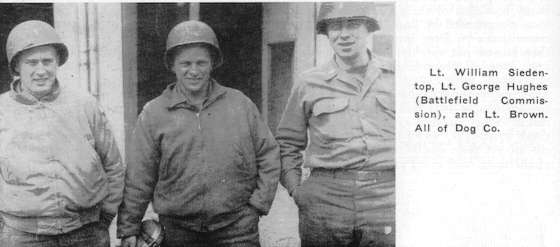 originally
started out as an infantry show, supported by tanks, but it gained momentum,
the tanks slammed ahead, leaving the doughs behind to mop up. Several heinie
artillery batteries were overrun and smashed during this hectic action,
The breakthrough had reached a point now that rendered close cooperation
between task forces impossible.
originally
started out as an infantry show, supported by tanks, but it gained momentum,
the tanks slammed ahead, leaving the doughs behind to mop up. Several heinie
artillery batteries were overrun and smashed during this hectic action,
The breakthrough had reached a point now that rendered close cooperation
between task forces impossible.
After the capture of Diebling by Company "C," its calm unhurried C.O. Captain James A. Russell, was ordered to attack Cadenbronn Heights. Moving quickly up on the right flank was Company "B" under Captain Ross C. Brown. The attack had been so vicious that we had now advanced beyond the objective assigned by higher headquarters, and Cadenbronn bad previously been reckoned a difficult objective to be assaulted at a later date. However, here was considered a chance to kill two birds with one stone. This attack jumped off at 1700 from Diebling; Company "B" while moving up the slopes northeast of Diebling came under heavy anti-tank fire from the vicinity of Metzing. It was dusk. Visibility was poor, and ground was extremely soft, thus greatly hindering their mobility. Company B, partially bogged down, was unable to extricate itself from this quagmire Enemy anti-tank guns in well defiladed positions blazed away at "Baker's right flank" and knocked out seven tanks. With their two remaining vehicles they took their part of the objective. The final objective was secured, by both Baker and Charlie at 1750.
During the above mentioned assault a very unusual incident occurred. Before Company A reached Metzing Lt. Kratzer's tank was hit and all members of the crew bailed out. Unknown to them Tech. 4th Grade Shunk, the driver had been instantly killed and he was in such a position that his foot kept the accelerator depressed and the vehicle rolled on in low gear, a dead man at the levers, through the enemy lines into the town, and beyond it, describing great lumbering circles before it came to a halt.

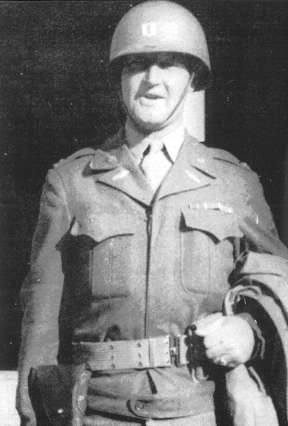 This
proved to be a costly, yet amazing successful day's operations, and all
involved were rightly proud of a job well done. We Tankers had stabbed
deep into the enemy's underbelly. We had them on the run but darkness dropped
a curtain on the day's operations.
This
proved to be a costly, yet amazing successful day's operations, and all
involved were rightly proud of a job well done. We Tankers had stabbed
deep into the enemy's underbelly. We had them on the run but darkness dropped
a curtain on the day's operations.
On the sixth the remaining elements of the task force closed in the vicinity of Tenteling, and when all the attachments reverted to Battalion control, we were assigned a defensive sector north of Ebering-Tenteling, under control of CCR. During the succeeding days until the 13th of December, we held and improved our defensive position. Then we were relieved in this sector by elements of the 9th AIB and 69th Tank Battalion. When the relief had been completed the Battalion went into Division reserve and moved into billets in Lanning, Maxstadt, and Biding, where we remained until December 17th and devoted our time to rest and refitting,
Then, on
the 18th of December the Battalion moved to Merlebach where all troops
were comfortably billeted in town. We continued our program of rest and
maintenance there, and entertainment was provided. Shower facilities were
excellent.
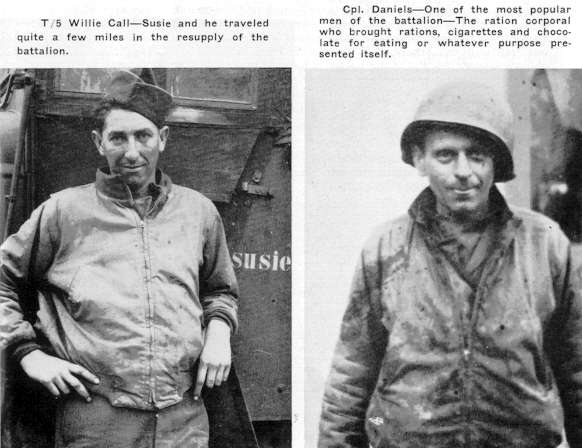
NOTE: Remove question mark from address below when sending email
This page is maintained by Bruce Frederick, EMAIL
.
Last updated: June 12, 1999.